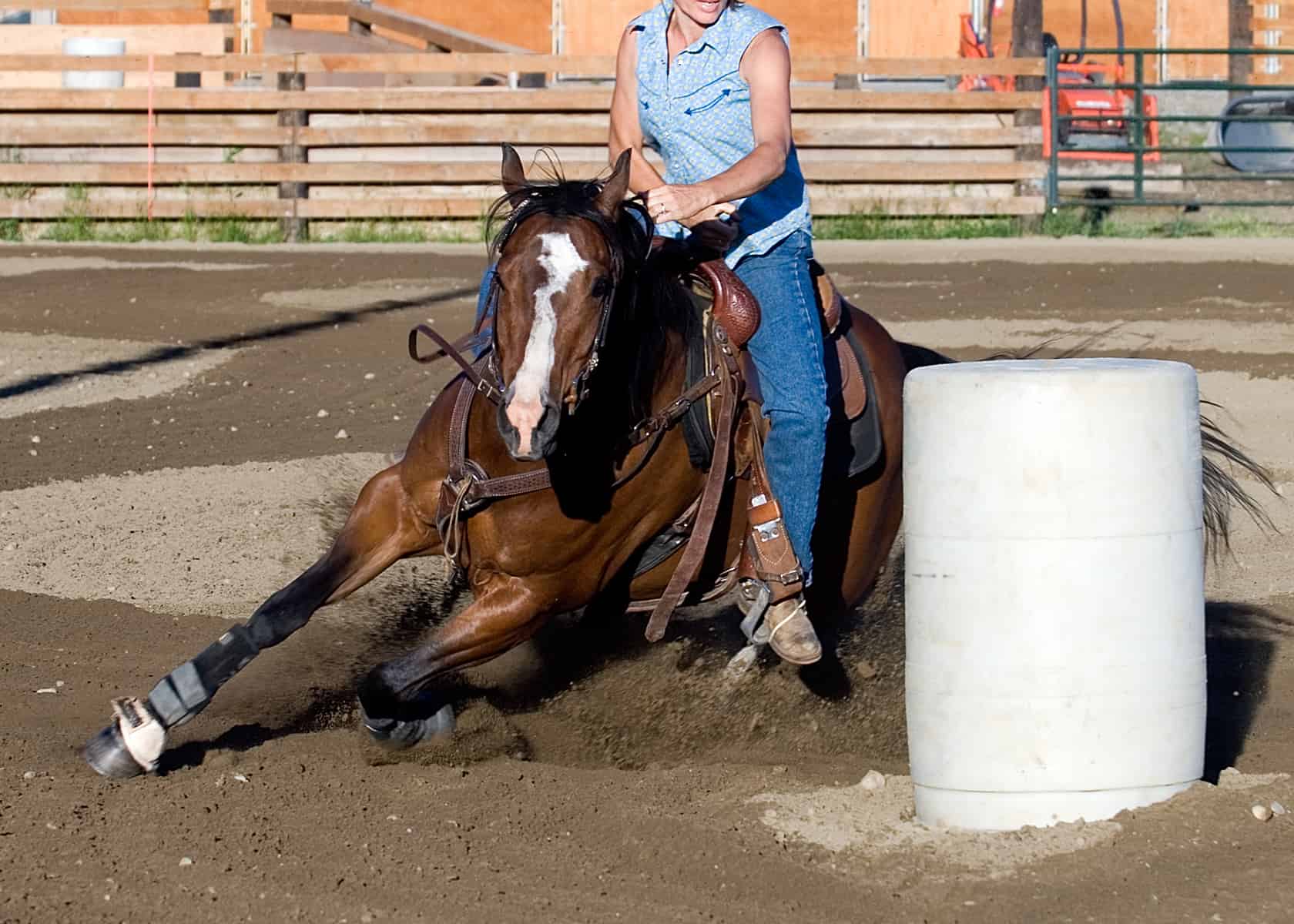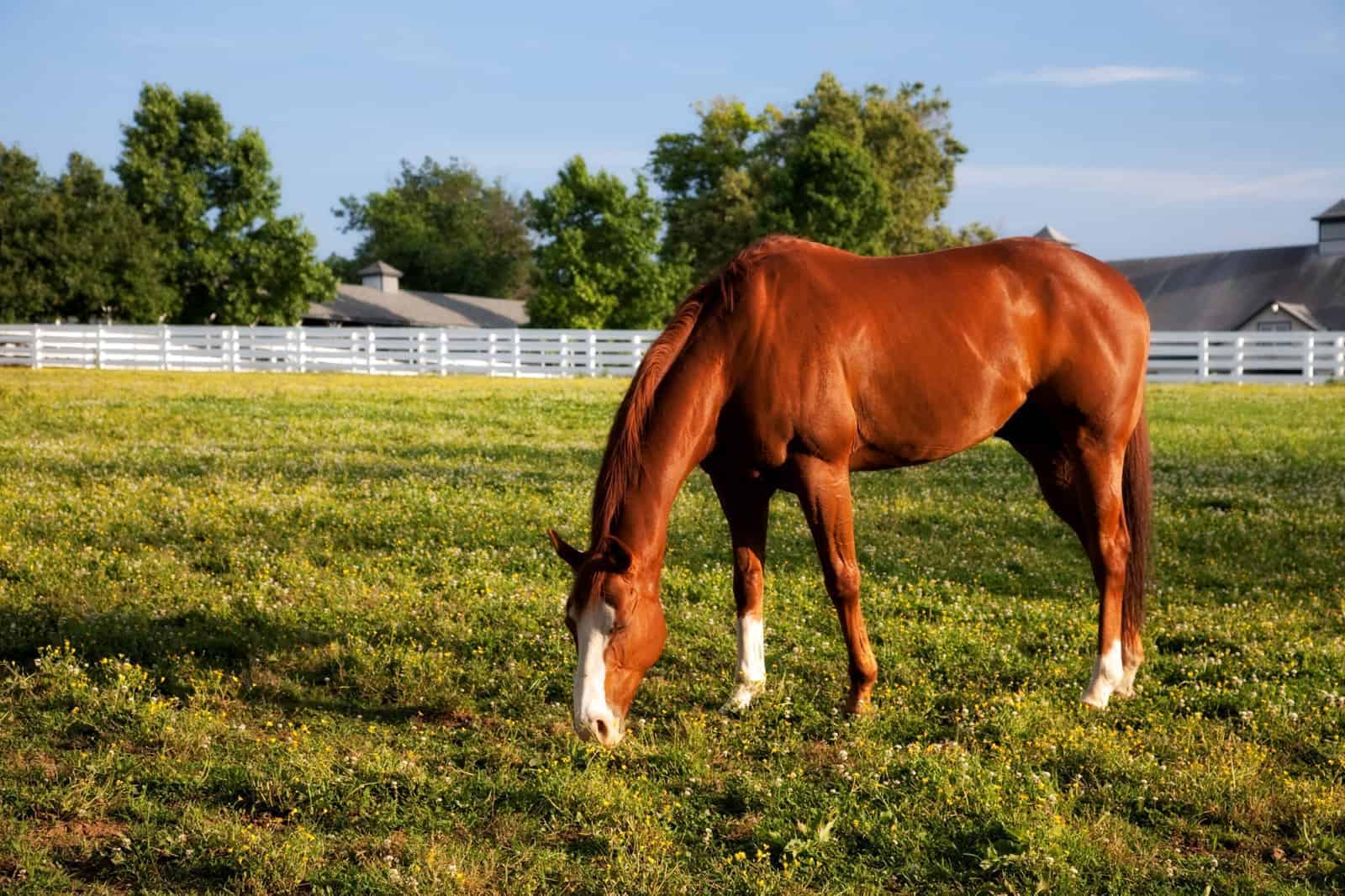Feeding the Anaerobic Equine Athlete

At the National Cutting Horse Association World Championship Futurity, the final seconds of competition can determine the champion. The winning horse stays with the last cow, preventing it from returning to the herd. Another horse loses its last cow just before the buzzer sounds, only to go home without placing. In many cases, the latter horse has simply run out of gas, says Karen Davison, PhD, an equine nutritionist and director of equine technical solutions for Purina Animal Nutrition, in Gray Summit, Missouri.
“Both horses are incredibly talented elite athletes,” she says. “One just didn’t have enough energy to sustain the high-intensity workout and make that final big move to hold the cow.”
Nutrition in the form of fats and carbohydrates (sugars, starches) is the fuel that sustains performance. However, the body uses these energy sources differently depending on a workout’s duration and intensity. Take aerobic exercise, for instance: During this longer-lasting, lower-intensity work such as endurance riding, the muscle tissues use oxygen to convert fat into energy. During the short bursts of high-intensity training that characterize anaerobic exercise, on the other hand, muscles don’t need oxygen to convert stored sugars into energy. Barrel racers, jumpers, racehorses, and rodeo horses that work hard for a few seconds to about 2 minutes typically fit this description, says Brian D. Nielsen, PhD, PAS, Dipl. ACAN, professor of equine exercise physiology at Michigan State University, in East Lansing.
“People tend to think their horse is working either anaerobically or aerobically,” says Clair Thunes PhD, an equine nutrition consultant and owner of Summit Equine Nutrition, in Gilbert, Arizona. “The horse’s muscles are actually doing both at the same time.”
Muscles are made up of many fibers. The number of fibers working aerobically versus anaerobically varies depending on how hard the horse is working, his fitness level, breed, and genetics. With all those variables, how do you build a nutritional program that supports your high-intensity equine athlete? Davison, Nielsen, and Thunes share their advice.
What’s on the Menu?
Indeed, equine athletes, regardless of the type, need energy to perform. While horses never work exclusively in aerobic or anaerobic mode, the intensity and duration of the exercise determines which mode they predominately work in. The diet must supply the right combination of fuel sources to best support the work. During lower-intensity, longer duration exercise, the body burns more stored fat. Dietary fats such as vegetable oils, rice bran, and oil seeds and fibers from forages, beet pulp, and soy hulls support these stores. As workout intensity increases, the body shifts to burning more anaerobic fuels, which come primarily from soluble carbohydrates, starches, and sugars, supplied mostly by grains.
“The harder and more repetitive work a horse does, the more they need these nutrients in their diet,” Davison says.
Researchers have proven that starches can aggravate muscle conditions such as tying-up caused by polysaccharide storage myopathy. And scientists have linked dietary sugar and starch with colic, laminitis, obesity, and insulin resistance (IR, a reduction in sensitivity to insulin that makes it harder for the fat, muscle, and liver cells to transport glucose—sugar—out of the bloodstream and store it as glycogen, a fuel source). But starch has an important place in a horse’s diet, especially a high-performance horse engaged in short bursts of high-intensity, anaerobic activity.
With that in mind, Davison stresses that every horse is an individual, and you must provide him with the fuel sources that best support his metabolism and exercise type and level. Prior to the introduction of commercially formulated feeds, Davison says owners knew to feed working horses grains such as corn, oats, and barley to help meet their energy needs.
These grains can contain as much as 40 to 70% starch. Researchers discovered that while horses need this nutrient, they typically didn’t need it in that quantity. Today, nutritionists recommend feeds with moderate amounts of about 25% starch, Thunes says. Horses with IR are typically limited to feeds with 10-14% nonstructural carbohydrates (NSCs, the sugars and starches in plants).
“Thoroughbred folks still feed up to 40% starch,” Thunes says. “Many trainers feed commercially produced products at less than the level on the label and then add oats. It’s hard to get people to shift away from that. Newer research is looking at reducing starch in racehorse diets and feeding fermentable fibers like soybean hulls and beet pulp as alternatives.”
Aerobic or Anaerobic?
Brian D. Nielsen, PhD, PAS, Dipl. ACAN, professor of equine exercise physiology at Michigan State University points to a horse’s respiration rate as one indicator of how your horse is primarily working. A horse that’s huffing or puffing to catch his breath after exercise but recovers quickly is usually working anaerobically.
“A horse that is overheated will also huff and puff but will take longer to regain their wind than a horse that has just finished exercise and needs to catch his breath,” he says. “When a horse’s respiration rate drops to normal within a few minutes, the horse has been working anaerobically.”
Davison notes that even aerobic athletes need these glucose stores. An endurance rider, for instance, is likely going to ask her horse to sprint across the finish line after several hours of slower, steadier work, she says.
Davison admits she sees some horse owners balk at the idea of increasing their horses’ sugar and starch intakes. They worry that the increased energy levels will affect the horse’s behavior. But each horse is an individual and responds differently.
“It’s like kids. You can give one a Snickers bar, and he will be bouncing off the walls,” she says. “You can give another kid the same candy, and she falls asleep on the couch for two hours. It comes down to what feel you want as a rider and finding a balance that works best for your horse.”
And sprinters need fat calories in addition to carbs, says Davison. While competition might call for speed, a lot of slow warming-up occurs before showtime.
“No one walks out of a stall and runs a barrel race,” she says. “There is some warmup and training before the race and work at home, and that is aerobic exercise that needs fat.”
An additional benefit of feeding fat is its glycogen-sparing effect. Horses can use fat provided in their diet preferentially while working slowly instead of tapping into stored glycogen reserves, Nielsen says. Then the horse has a “full gas tank” of glycogen to use on competition day. If a horse doesn’t have enough fat in his diet, he might use some of his glycogen reserves when working slowly and enter competition with a depleted tank.
Generally, a ration with 8-10% fat is sufficient for anaerobic athletes. A total diet that’s more than 10% fat, including forage, formulated feed, and supplements, can overwhelm a horse’s ability to absorb fat, resulting in loose stool.
“The positive thing about feeding fat is when it is burned it generates less heat than when the horse is burning carbohydrates,” Nielsen says. “In hot climates a horse can lose a lot of energy to heat so when they burn fat instead of carbohydrates (when working), they are losing less energy.”

Don’t Forget About Forage
Before horses were domesticated and used as work animals or competition partners, they obtained all their necessary nutrients through grazing. With work came greater energy needs and reduced access to unlimited forage, so grains were added to their diets. Then came the development of commercialized feeds.
Many people believe a forage-only diet isn’t sufficient for performance horses doing anaerobic work. However, Nielsen points to new research out of Sweden that suggests these horses can perform at high levels on forage alone.
“There is a team studying this in trotters,” he says. “The horses in the group are being successful with a complete forage diet.”
It’s a concept he unscientifically experiments with in his own herd of racing Quarter Horses. He’s raised them on pasture, hauling to the track just for races days, and they’ve won their fair share. He acknowledges there’s no proof they wouldn’t do better with added grain or different genetics—his experience has only been running his horses housed on pasture and consuming lush grass high in soluble carbohydrates.
However, a forage-only diet comes with caveats, Nielsen says. In Sweden the horses have access to an abundant source of soluble carbs in the lush green pastures and hay found there. In the U.S. racehorses don’t typically have the luxury of grazing on immature grass; they’re confined to stalls at the track. Also, the hay that’s readily available in the U.S. doesn’t contain similarly high levels of soluble fibers. “There’s still a lot of research that needs to be done,” he says.
The Key to Success: Balance
Many human athletes “carb-load” the night prior to competition; it’s not uncommon for runners and swimmers to fill up on pasta before a race or a meet. But this approach doesn’t seem to be effective in horses, Thunes says. Overloading a horse with carbohydrates before intense exercise can be potentially dangerous and even lead to colic.
When you carb-load by feeding a lot of starch in one meal, you can overwhelm the small intestine’s ability to digest and remove the starch. This can lead to starch accumulation in the hindgut, where it is rapidly fermented, producing gas and affecting pH levels and the hindgut environment, potentially killing off good bacteria, releasing toxins, etc., says Davison.
Dr. Karen Davidson
“You don’t want to feed starch within three hours of exercise because it impacts the substrate available for energy use,” she says. “This gets kind of tricky when you have an 8 a.m. start time.”
Another key difference between human and equine athletes is the time it takes to refill depleted glycogen stores. It takes people 24 hours and horses closer to 72 hours, says Davison.
“When a horse has a multiday competition, and they use glycogen stores several days in a row, they may not have enough to replenish what has been used, and that can show up in the finals when it really counts,” she says.
People often forget that water is a nutrient, and a critical one at that. Hydrating a horse after exercise is key.
“Dehydrated horses will not be able to replenish stored carbohydrates as well,” says Thunes. “Water is part of the glycogen-storing process. Horses drinking a saline solution after intense work have been shown to … drink more, which helps increase the tissue’s glycogen-storing capabilities.”
Regardless of the discipline, the key to developing a nutritional program for a high-performance equine athlete doing short, intense work is to remember that each horse is an individual.
“There are horse owners in the same discipline who don’t feed the same thing,” Davison says. “The Top 15 barrel racers at the National Finals Rodeo all feed something different. It’s all about what the rider wants and what works best for that individual horse.”
Written by:
Katie Navarra
Related Articles
Stay on top of the most recent Horse Health news with















